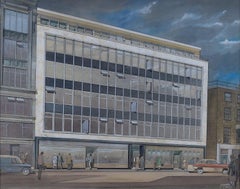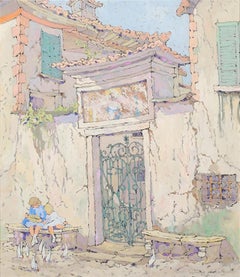John Dean Monroe Harvey Art
Probably unrivaled as an architectural perspectivist working after the Second World War, John Dean Monroe Harvey trained as an architect but after 1944 worked almost solely on drawing architectural perspectives for other architects. “The architectural draughtsman who is equally competent at drawing such incidentals [as landscape and figures] is as rare as the landscape or figure painter who is equally competent at architecture. Harvey was one of those rare men. He would draw a building with a slightly freer hand than an architect would, and his landscape in a slightly more architectural manner than that of a painter.” Perspective in Perspective, Lawrence Wright (Routledge 1983) p234. Harvey was born in Newfoundland, where his father was a railway engineer, and came to England aged 17, studying at St Paul’s School, London and the School of Architecture, University College London 1914–18, being awarded the Donaldson medal. In 1920 he went into practice on his own, designing several interiors with J A Bowden. Amongst his works were the reconstruction and interior decoration of 4 Cleveland Place, London (1936–37), and a house – including all furnishings – in Herne Hill for Dr. M I Elliot (1938). After 1944, he primarily worked as a perspective artist and illustrator, a role to which he was particularly well suited. During the war, he was a member of St Paul’s Watch, a group of over 100 architects and surveyors and artists who kept watch over St Paul’s Cathedral during the blitz, extinguishing fires and helping St Paul’s to survive the war virtually unscathed. The Watch was described as the Best dining club in London on account of its influential members. Harvey later retired to Italy, living on the shore of Lake Como, and enjoying the local red wine.
1960s Modern John Dean Monroe Harvey Art
Pencil, Gouache
Mid-20th Century John Dean Monroe Harvey Art
Mixed Media
1960s Modern John Dean Monroe Harvey Art
Pencil, Watercolor
Mid-20th Century Realist John Dean Monroe Harvey Art
Mixed Media
1960s Realist John Dean Monroe Harvey Art
Gouache
Early 20th Century Realist John Dean Monroe Harvey Art
Paper
20th Century American Realist John Dean Monroe Harvey Art
Paper, Gouache
Early 2000s Realist John Dean Monroe Harvey Art
Cotton, Mixed Media, Screen
Early 20th Century Impressionist John Dean Monroe Harvey Art
Watercolor, Gouache, Pencil
2010s Realist John Dean Monroe Harvey Art
Textile, Mixed Media
20th Century American Modern John Dean Monroe Harvey Art
Paper, Watercolor, Graphite
21st Century and Contemporary Realist John Dean Monroe Harvey Art
Mixed Media, Canvas, Oil, Acrylic
1880s Naturalistic John Dean Monroe Harvey Art
Paper, Watercolor, Gouache, Pencil
20th Century American Modern John Dean Monroe Harvey Art
Paper, Watercolor, Graphite
1930s American Modern John Dean Monroe Harvey Art
Gouache, Oil, Board
1830s Folk Art John Dean Monroe Harvey Art
Paper, Watercolor, Gouache, Pencil
2010s Realist John Dean Monroe Harvey Art
Gesso, Canvas, Paint, Cotton Canvas, Mixed Media, Acrylic, Watercolor


